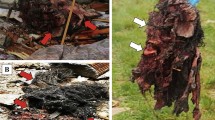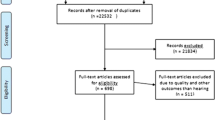Abstract
Objectives
In various investigated populations, sensitization to cockroaches was observed in 8% of screened subjects from temperate climatic zones and in 36% of those from tropical zones. Because of the numerous hiding places and food storages aboard a ship the crews can be highly exposed to cockroaches. The aim of this study is to assess the prevalence of sensitization to cockroaches and potentially associated health risks in seafarers.
Methods
In July 2005, a total of 145 seamen sailing under the German flag were recruited from a medical surveillance program for a cross-sectional study (response 95.4%). A standardized interview and a skin prick test (SPT) with nine common inhalant allergens and a cockroach extract (Blatella germanica) were performed. In cockroach-sensitized seafarers total and cockroach-specific IgE was measured and lung function tests conducted.
Results
In total, 39 seamen (26.9%) were cockroach-sensitized according to SPT results. Presence of cockroach sensitization in seamen from the tropical zone (37.3%) was significantly higher than in seamen from the temperate zone (21.3%) (odds ratio 2.20, 95% confidence interval 1.04–4.66). The prevalence of sensitization to any of the other nine common allergen mixtures tested was lower (between 2.1 and 12.4%). Neither current or past cockroach exposure on board nor cumulative cockroach exposure and time since last cockroach exposure were associated with cockroach sensitization. Among cockroach SPT-positive seamen, cockroach-specific IgE was detected in 52.8%. Five out of 37 (13.5%) SPT-positive seamen exhibited an obstructive ventilation pattern. The prevalence of work-related atopic symptoms was 9.0% (n = 13). These symptoms were not related to cockroach sensitization.
Conclusion
The high prevalence of sensitization to cockroaches among seamen in the presented study emphasizes the strong sensitization potency of these insects. Longitudinal studies and bronchial cockroach challenge tests are necessary to assess the clinical relevance of cockroach sensitization aboard a ship in more detail.
Similar content being viewed by others
References
American Thoracic Society (2005) Standardization of spirometry: 2005 update. Eur Respir J 26:319–338
Arbes SJ, Gergen PJ, Elliott L, Zeldin DC (2005) Prevalences of positive skin test responses to 10 common allergens in the US population: results from the third National Health and Nutrition Examination Survey. J Allergy Clin Immunol 116:377–383
Arruda LK, Ferriani VP, Vailes LD, Pomes A, Chapman MD (2001) Cockroach allergens: environmental distribution and relationship to disease. Curr Allergy Asthma Rep 1:466–473
Birkhof R (2002) Hausstaubmilben und Schaben als Auslöser allergischer Erkrankungen. [Mites and cockroaches as risk factors of allergic diseases] Dissertation, Ludwig-Maximilian-University of Munich, Germany (submitted)
Birnbaum J, Guilloux L, Charpin D, Vervloet D (1991) Cockroach allergens. Lancet 337:249
Carlsen KC, Carlsen KH, Buchmann MS, Wikstrom J, Mehl R (2002) Cockroach sensitivity in Norway: a previously unidentified problem? Allergy 57:529–533
Christiansen SC, Martin SB, Schleicher NC, Koziol JA, Hamilton RG Zuraw BL (1996) Exposure and sensitization to environmental allergen of predominantly Hispanic children with asthma in San Diego’s inner city. J Allergy Clin Immunol 98:288–329
Cuesta C, Placido JL, Delgado L, Miranda M, Moreira Silva JP, Castel-Branco MG Vaz M (1995) Alergia a la cucaracha: estudio de su prevalencia mediante pruebas cutáneas con extractos comerciales. [Cockroach allergy: a study of its prevalence using skin tests with commercial extracts]. Allergol Immunopathol (Madr) 23:295–300
Dudek W, Walusiak J, Wittczak T, Krakowiak A, Marciniak-Bielak D, Raulf-Heimsoth M, Palczynski C (2005) Natural rubber latex allergy: antigen-specific IgE in Polish blood donors, prevalence and risk factors—preliminary data. Int J Occup Med Environ Health 18:35–42
Eggleston PA, Rosenstreich D, Lynn H, Gergen P, Baker D, Kattan M, Mortimer KM, Mitchell H, Ownby D, Slavin R, Malveaux F (1998) Relationship of indoor allergen exposure to skin test sensitivity in inner-city children with asthma. J Allergy Clin Immunol 102:563–570
Gelber LE, Seltzer LH, Bouzoukis JK, Pollart SM, Chapman MD, Platts-Mills TA (1993) Sensitization and exposure to indoor allergens as risk factors for asthma among patients presenting to hospital. Am Rev Respir Dis 147:573–578
Gold DR, Burge HA, Carey V, Milton DK, Platts-Mills T, Weiss ST (1999) Predictors of repeated wheeze in the first year of life: the relative roles of cockroach, birth weight, acute lower respiratory illness, and maternal smoking. Am J Respir Crit Care Med 160:227–236
Hirsch T, Stappenbeck C, Neumeister V, Weiland SK, von Mutius E, Keil U, Leupold W (2000) Exposure and allergic sensitization to cockroach allergen in East Germany. Clin Exp Allergy 30:529–537
Huss K, Adkinson NF Jr, Eggleston PA, Dawson C, van Natta ML, Hamilton RG (2001) House dust mite and cockroach exposure are strong risk factors for positive allergy skin test responses in the Childhood Asthma Management Program. J Allergy Clin Immunol 107:48–54
Kang BC, Chang JL, Johnson J (1989) Characterization and partial purification of the cockroach antigen in relation to housedust and housedust mite (D.f.) antigens. Ann Allergy 63:207–212
Kim YY, Cho SH, Kim WK, Park JK, Song SH, Kim YK, Jee YK, Ha MN, Ahn YO, Lee SI, Min KU (1997) Prevalence of childhood asthma based on questionnaires and methacholine bronchial provocation test in Korea. Clin Exp Allergy 27:761–768
Leung R, Jenkins M (1994) Asthma, allergy and atopy in southern Chinese school students. Clin Exp Allergy 24:353–358
Liccardi G, Russo M, D’amato M, Granata FP, De Napoli A, D’amato G (1997) Sensitization to cockroach allergens in a sample from the urban population living in Naples (southern Italy). J Investig Allergol Clin Immunol 8:245–248
Mungan D, Celik G, Sin B, Bavbek S, Demirel Y, Misirligil Z (1998) Characteristic features of cockroach hypersensitivity in Turkish asthmatic patients. Allergy 53:870–873
Pumhirun P, Towiwat P, Mahakit P (1997) Aeroallergen sensitivity of Thai patients with allergic rhinitis. Asian Pac J Allergy Immunol 15:183–185
Quanjer PH, Tammeling GJ, Cotes JE, Pedersen OF, Peslin R, Yernault JC (1993) Lung volumes and forced ventilatory flows. Report working party standardization of lung function tests, European Community for steel and coal. Official Statement of the European Respiratory Society. Eur Respir J 16:5–40
Reese G, Ayuso R, Lehrer SB (1999) Tropomyosin: an invertebrate pan-allergen. Int Arch Allergy Immunol 119:247–258
Rosenstreich DL, Eggleston P, Kattan M, Baker D, Slavin RG, Gergen P, Mitchell H, Mcniff-Mortimer K, Lynn H, Ownby D, Malveaux F (1997) The role of cockroach allergy and exposure to cockroach allergen in causing morbidity among inner-city children with asthma. Department of Medicine, Albert Einstein College of Medicine, Bronx, NY 10461, USA. N Engl J Med 336:1356–1363
Sarpong SB, Hamilton RG, Eggleston PA, Adkinson NF (1996) Socioeconomic status and race as risk factors for cockroach allergen exposure and sensitization in children with asthma. J Allergy Clin Immunol 97:1393–1401
Sastre J, Ibanez MD, Lombardero M, Laso MT, Lehrer S (1996) Allergy to cockroaches in patients with asthma and rhinitis in an urban area (Madrid). Allergy 51:582–586
Stankus RP, O’Neil CE (1988) Antigenetic/allergic characterization of American and German cockroach extacts. J Allergy Clin Immunol 81:563–570
Squillace SP, Sporik RB, Rakes G, Couture N, Lawrence A, Merriam S, Zhang J, Platts-Mills AE (1997) Sensitization to dust mites as a dominant risk factor for asthma among adolescents living in central Virginia. Multiple regression analysis of a population-based study. Am J Respir Crit Care Med 156:1760–1764
Tandon N, Maitra SB, Saha GK, Modak A, Hati AK (1990) Role of cockroaches in allergy to house dust in Calcutta, India. Ann Allergy 64:155–157
Thefeld W, Stolzenberg H, Bellach B-M (1999) Bundes-Gesundheitssurvey: response, Zusammensetzung der Teilnehmer und Non-Responder-Analyse. [German National Health Interview and Examination Survey: composition of participants, and analysis of non-respondents]. Gesundheitswesen 2:57–61
Witteman AM, van den Oudenrijn S, van Leeuwen J, Akkerdaas J, van der Zee Js, Aalberse Rc (1995) IgE antibodies reactive with silverfish, cockroach and chironomid are frequently found in mite-positive allergic patients. Int Arch Allergy Immunol 108:165–169
Zwick H, Popp W, Sertl K, Rauscher H, Wanke T (1991) Allergenic structures in cockroach hypersensitivity. J Allergy Clin Immunol 87:626–630
Acknowledgments
The authors thank all seamen who participated in our study. Furthermore, we would like to thank Dr. B. Schepers, M. Böckmann-Friedrich and U. Brettmann of the statutory seafaring accident insurance institution (“See-BG”) for their great on-the-spot support. In addition, the authors express their gratitude to the following co-workers from different departments of the Institute of Occupational and Maritime Medicine (ZfAM), in particular to D. Johannsen and E. Nern of the Clinical Department, to Dr. C. Bittner and S. Finger of the Allergology Department as well as to U. P. Huesing, W. Mueller, M. Kalkowski, M. Boeger and Dr. M. Puskeppeleit of the Hamburg Port Health Authority for their active support during this study.
Author information
Authors and Affiliations
Corresponding author
Rights and permissions
About this article
Cite this article
Oldenburg, M., Latza, U. & Baur, X. Occupational health risks due to shipboard cockroaches. Int Arch Occup Environ Health 81, 727–734 (2008). https://doi.org/10.1007/s00420-007-0247-3
Received:
Accepted:
Published:
Issue Date:
DOI: https://doi.org/10.1007/s00420-007-0247-3




